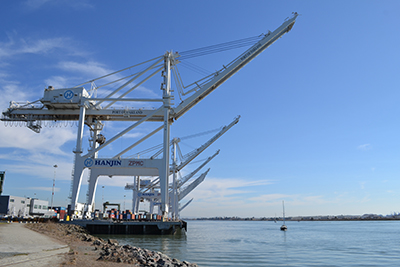Port of Oakland forecasts record container throughput in coming years
The blueprint for the future foresees increased cargo volume arriving at Oakland on larger ships. Northern California’s “booming” freight market will drive the growth.

Port of Oakland maritime officials anticipate a five-year run of record cargo volume beginning next year. By 2022, the port expects to handle the equivalent of 2.6 million 20-foot containers (TEUs) annually.
This represents an 8 percent volume increase over what this ocean cargo gateways has has ever processed in a single year.
The figures appear in a Strategic Maritime Roadmap released by the port this month.
The blueprint for the future foresees increased cargo volume arriving at Oakland on larger ships. Northern California’s “booming” freight market will drive the growth, the port said. New logistics capabilities, such as distribution centers and freight transfer facilities, should provide a further boost, it added.
Walter Kemmsies, Managing Director, Economist and Chief Strategist of JLL’s Port, Airport and Global Infrastructure (PAGI) group, told LM in an interview that Oakland is becoming an even stronger port of outbound cargo.
“And that’s where the future is,” he said. “There is growing evidence that U.S. exports are going to be an ever more vital part of our global trade strategy. Oakland is a key player in that sector.”
Oakland’s Maritime Director, John Driscoll, agrees, noting that the port is serving a thriving area and developing new services for shippers.
“The combination should be positive for everyone who relies on the port for their business or their job,” he said.
The port’s “Roadmap” forecasts record volume of more than 2.4 million cargo containers in 2018. The current record is 2.39 million set three years ago. The Port said it anticipates steady growth – and new volume records - for the next five years.
The port predicted that vessels arriving here would be 35 percent larger within 15 years. They’ll carry up to 18,000 containers, reducing the number of ships needed in Oakland. That should help mitigate the impact of cargo growth.
“Fewer ships means fewer diesel exhaust emissions,” observed Oakland’s director of communications, Mike Zampa.
The port said its new logistics developments will rise near rail lines to reduce the reliance on trucks. That’s expected to further curb diesel emissions.
Oakland’s “Roadmap” includes a commercial strategy calling for:
- Growing business from local and regional markets
- Remaining the top export gateway for California Central Valley growers
- Increasing U.S. Midwest meat and grain exports
- Attracting containerized cargo to a new refrigerated distribution center and to the 440,000-square-foot first phase of its Seaport Logistics Complex
- Increasing to 15 percent the amount of import cargo that arrives in Oakland and is loaded to the rails for inland distribution
- Attracting more automotive imports; and
- Making Oakland the first U.S. port of call for at least one vessel service originating in Asia.

Article Topics
Ports News & Resources
U.S.-bound import growth track remains promising, notes Port Tracker report Q&A: Port of Oakland Maritime Director Bryan Brandes Signs of progress are being made towards moving cargo in and out of Baltimore New Breakthrough ‘State of Transportation’ report cites various challenges for shippers and carriers in 2024 Industry experts examine the impact of Baltimore bridge collapse on supply chains Port of Baltimore closed indefinitely to ships after 1.6-mile Key Bridge collapses following maritime accident February and year-to-date U.S. import growth is solid, reports S&P Global Market Intelligence More PortsLatest in Logistics
Baltimore suing ship that crashed into bridge, closing port, costing jobs Intermodal growth volume remains intact in March, reports IANA Descartes announces acquisition of Dublin, Ireland-based Aerospace Software Developments Amid ongoing unexpected events, supply chains continue to readjust and adapt Shipment and expenditure decreases trend down, notes Cass Freight Index March trucking tonnage trends down, reports ATA FTR Shippers Conditions Index enters negative territory More LogisticsAbout the Author
Subscribe to Logistics Management Magazine

Find out what the world's most innovative companies are doing to improve productivity in their plants and distribution centers.
Start your FREE subscription today.
April 2023 Logistics Management

Latest Resources














